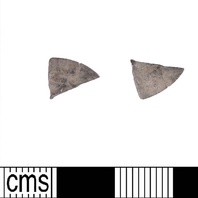
Viking Objects
Arabic Dirham Fragment (LIN-5F318A)
Fragment of an Early Medieval Arabic dirham, probably dating between the eighth-ninth centuries. The fragment appears to have been cut down into a smaller module. The fact that it may have been cut suggests that it was used as part of a bullion transaction in line with the dual bullion-monetary economy established by the Vikings in England. The circulation of Arabic dirhams is generally attributed to Viking activities and this example’s proximity to the winter camp of Torksey likely connects the dirham with the activities of its inhabitants. Arabic coins are especially useful for dating sites, because they carry the date when they were minted. This permits precise dating where the part of the coin with the date survives, whereas European coins can only be dated to the reign of the ruler depicted on them. In western descriptions of these coins, the Arabic dates found on the coins are usually listed in square brackets, as above, and the European equivalent is listed after it. This coin is a product of the Abbasid Caliphate which was ruled from its capital in Baghdad. The Abbasid Caliphate was at its greatest extent c.850 CE, occupying lands from Morocco in the west to Afghanistan in the east.
Read More
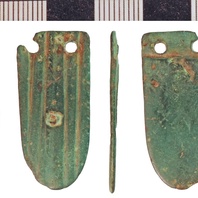
Viking Objects
Copper-Alloy Strap-End (NLM-B633CE)
The decoration on this cast copper-alloy strap-end involves a series of deep longitudinal grooves which may actually represent previous damage. If decorative, the object is similar to Thomas Class E Type 3 strap ends whose distribution generally falls in the eastern Danelaw and around the Irish Sea. Strap ends came in various styles and were fairly common throughout the Viking world. They were used to decorate the ends of belts and to stop them getting damaged.
Read More
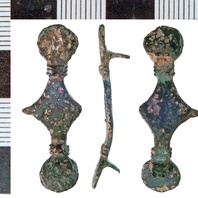
Viking Objects
Frankish Brooch (NLM-826868)
This copper-alloy brooch is either an equal-armed or ansate brooch. The ansate form is a Frankish style. It is possible that it made its way to England prior to Viking incursions but it is equally likely that the Vikings brought this brooch with them as plunder after raiding in Frankia. For more information on Scandinavian jewellery in England check out our blog: Brooches, Pendants and Pins: Scandinavian Dress Accessories in England.
Read More
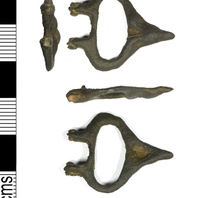
Viking Objects
Copper Alloy Buckle (LEIC-917DEC)
This buckle consists of an oval loop with a circular cross section and has an elongated triangular pin rest in the form of an animal head. The animal head has a pointed snout, rounded head with rounded upwards pointing ears which merge into the buckle loop. At the opposite side there are two short sub-rectangular cross-sectioned shafts which would have housed an iron pin that held the buckle pin and possibly an articulated plate.
Read More
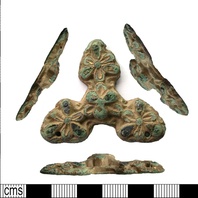
Viking Objects
Carolingian Trefoil Mount (LEIC-C5F14A)
This Carolingian trefoil mount has holes drilled through it for affixing to a surface, possibly a book. It is likely to have been brought from the European continent by Viking raiders or traders.
Read More
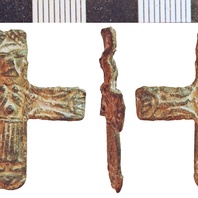
Item
Crucifix Pendant (NLM-AD60CD)
The settlement of Scandinavians in the Danelaw inevitably led in the end to their conversion to Christianity, though how this process happened and how long it took varied in different parts of the country and is still not fully understood. Finds from Scandinavian-settled areas, like this crucifix with a clear image of Christ on the cross, may well be evidence for this process.
Read More
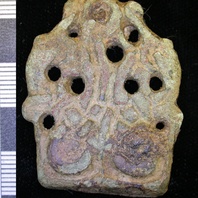
Viking Objects
Stirrup Mount (LEIC-C97582)
This example of a copper-alloy stirrup-strap mount is decorated with an interlaced design forming two ‘serpents’ interrupted by nine circular holes. It is similar to mounts of William Class A Type 1 but the holes and its large size match Class C mounts more closely.
Read More
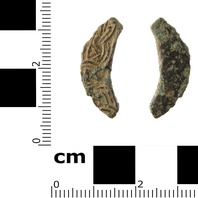
Viking Objects
Copper-Alloy Buckle Fragment (SWYOR-1F57BC)
This copper-alloy fragment is probably part of a flat buckle-frame decorated with Borre-style interlace though very few comparable examples exist.
Read More
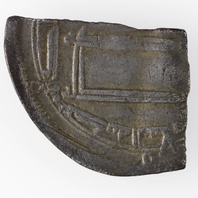
Viking Objects
Abbasid Silver Dirham (CM_773_2008)
This coin was minted at al-‘Abbasiyya. The dirham was a unit of weight used across North Africa, the Middle East, and Persia, with varying values which also referred to the type of coins used in the Middle East during the Viking Age. These coins were extremely prized possessions not only for their silver value but as a way of displaying ones wealth and vast trade connections. Millions of Arabic Dirhams would have been imported throughout the Viking world and are mostly found in hoards. Reduction in access to silver coins like this is thought to have been one of the causes of the Viking Age.
Read More
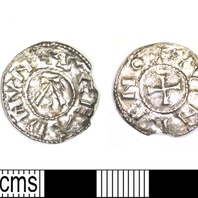
Viking Objects
St Edmund Penny (LEIC-4FC58C)
Between 895 and 915, Scandinavian settlers in East Anglia minted a series of pennies and half pennies with the inscription SCE EADMVND REX (St Edmund the king). These coins appear to have been used widely throughout the Danelaw, and a large number of them were discovered in the Cuerdale Hoard from Lancashire. This coin appears to have been made with a poorly engraved die and features a blundered inscription naming the moneyer. The Portable Antiquities Scheme suggests that the moneyer’s name was Winegar. The inscription reads YVINRE NO.
Read More
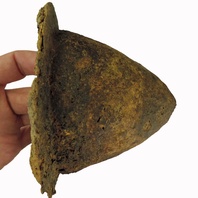
Viking Objects
Shield Boss (1989-59/9013)
This is a probable Viking shield boss from Repton, Derbyshire. This shield boss is possible evidence for the Viking Great Army’s overwintering at Repton in 873. The typical construction of a ‘Viking’ shield at the time involved several wooden planks glued together and cut into a circle. The face of the shield was then covered in linen or rawhide with rawhide edging that was either tacked or sewn on. Finally, a metal boss would be attached along with the handle over a hole in the centre. The purpose of the metal boss was to protect the user’s hand in combat.
